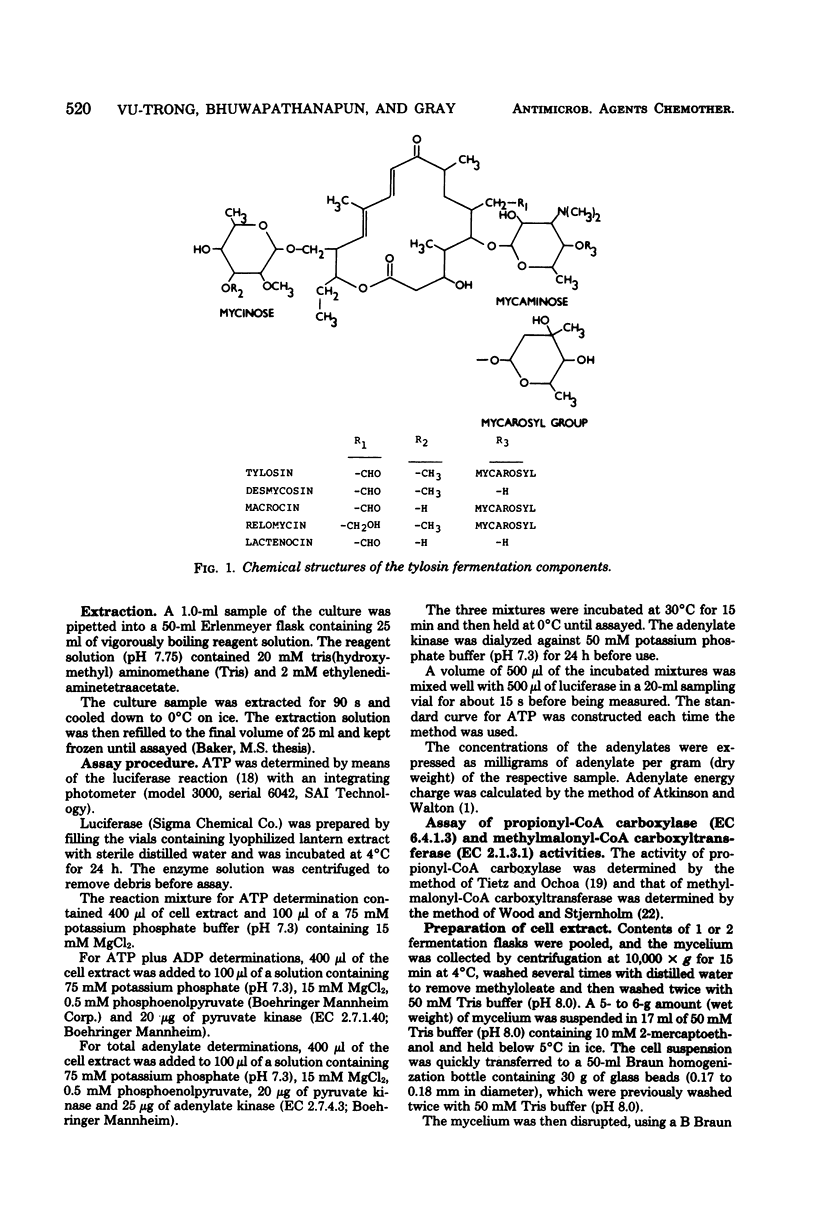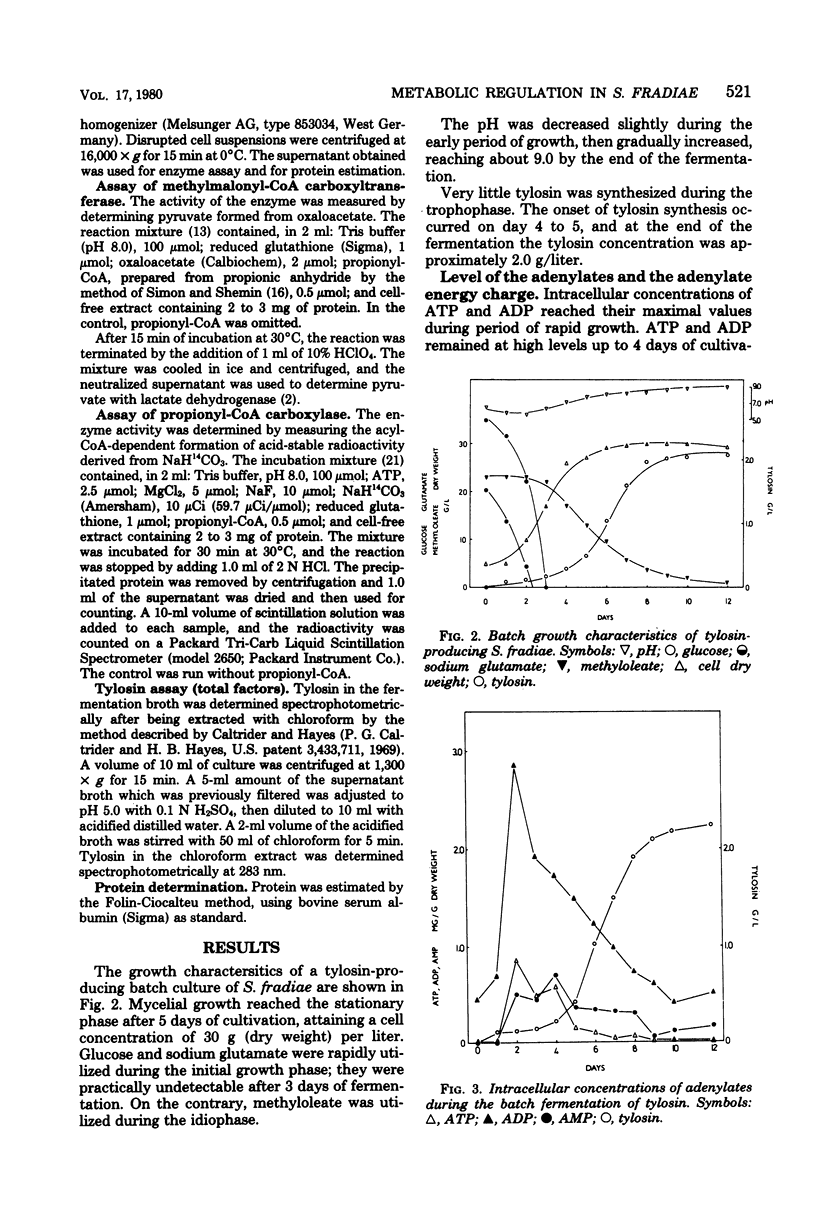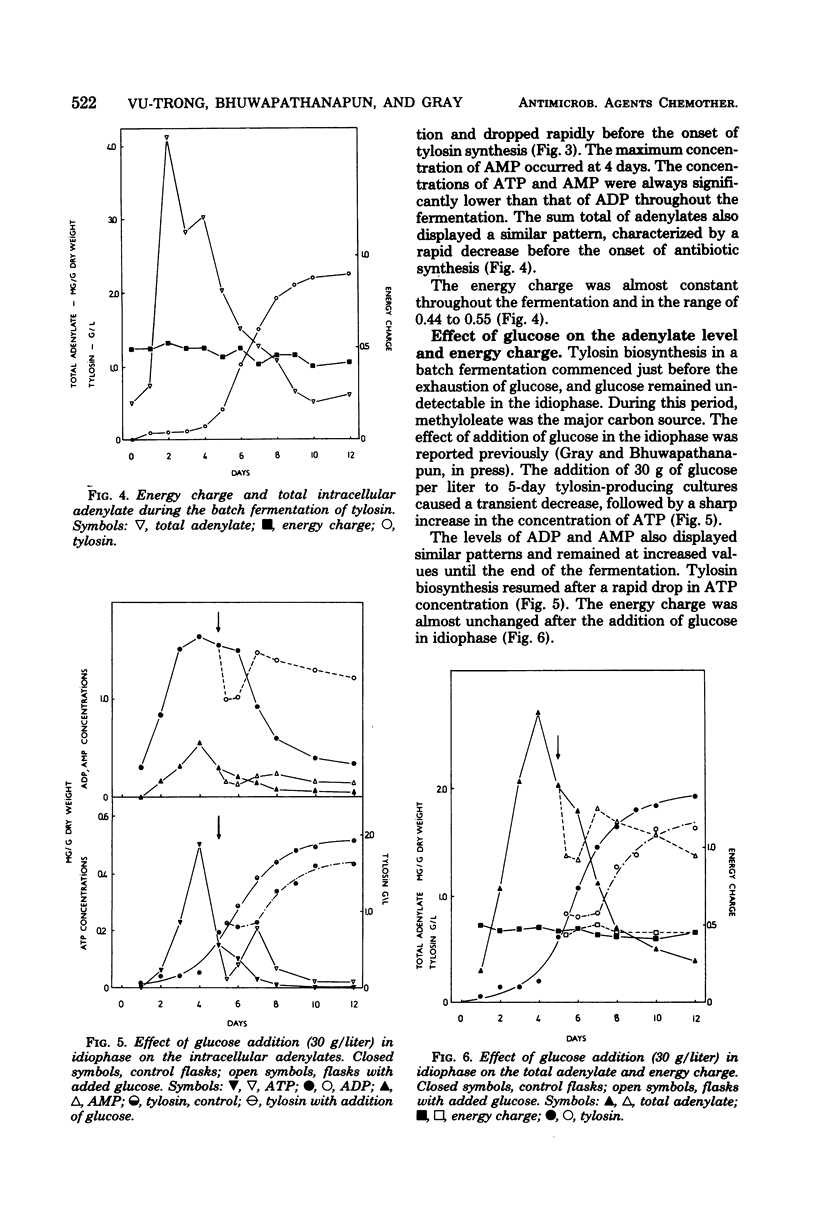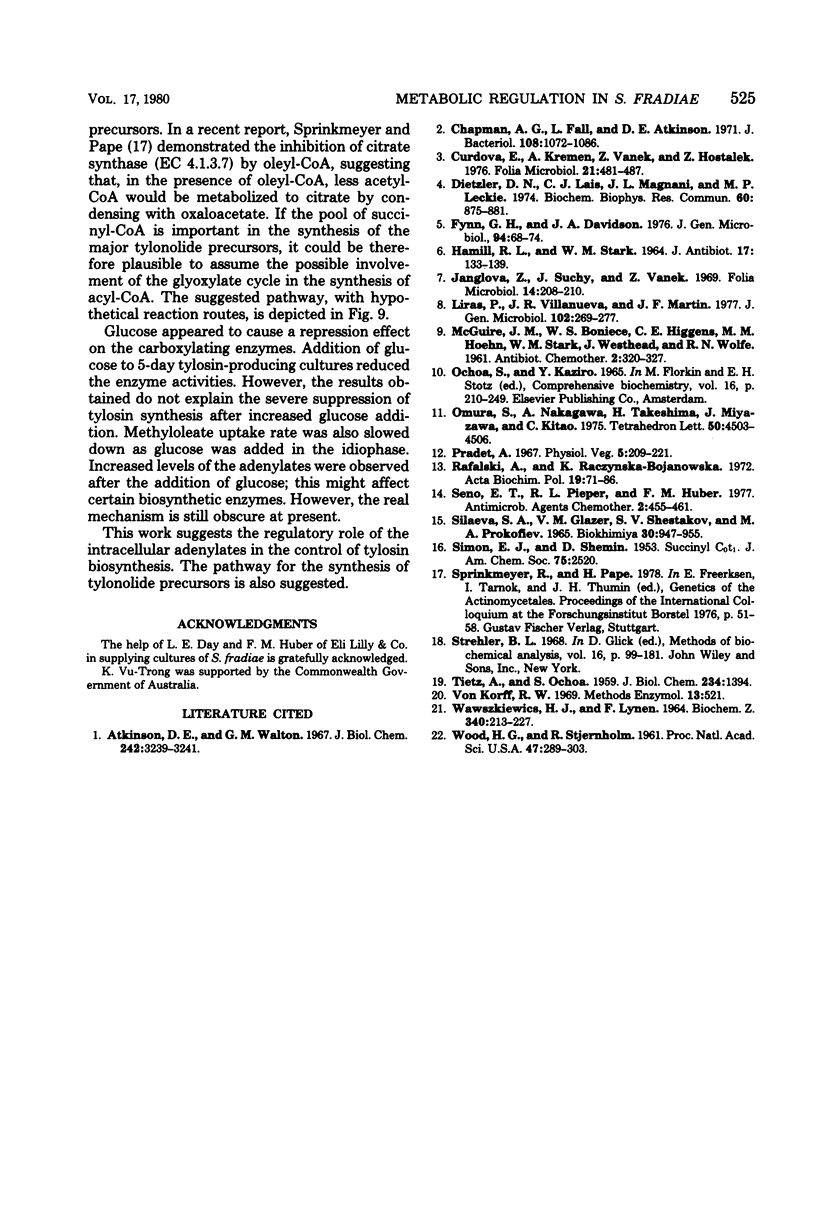Abstract
The relationship was studied between the level of the intracellular adenylates and the biosynthesis of tylosin by Streptomyces fradiae NRRL 2702. The adenylate level was observed to be inversely related to the rate of tylosin biosynthesis and hence the final concentration of the antibiotic. The concentrations of the adenylates were maximal during the trophophase, dropped quickly before the onset of tylosin biosynthesis, and remained at low levels throughout the idiophase. The adenylate energy charge was almost constant throughout the fermentation and was in the range of 0.4 to 0.55. Glucose addition in the idiophase suppressed tylosin biosynthesis, accompanied by a rapid increase in the adenylate levels. The biosynthesis of tylosin resumed after a rapid drop in the adenosine triphosphate concentration. Two enzymes catalyzing the interconversion of propionyl-coenzyme A and methylmalonyl-coenzyme A were found in this organism: methylmalonyl-coenzyme A carboxyltransferase (EC 2.1.3.1) and propionyl-coenzyme A carboxylase (EC 6.4.1.3). The activity of the former was two orders of magnitude higher than that of the latter. The activities of both enzymes were affected by the increased glucose addition in the idiophase.
Full text
PDF






Selected References
These references are in PubMed. This may not be the complete list of references from this article.
- Atkinson D. E., Walton G. M. Adenosine triphosphate conservation in metabolic regulation. Rat liver citrate cleavage enzyme. J Biol Chem. 1967 Jul 10;242(13):3239–3241. [PubMed] [Google Scholar]
- Chapman A. G., Fall L., Atkinson D. E. Adenylate energy charge in Escherichia coli during growth and starvation. J Bacteriol. 1971 Dec;108(3):1072–1086. doi: 10.1128/jb.108.3.1072-1086.1971. [DOI] [PMC free article] [PubMed] [Google Scholar]
- Curdová E., Kremen A., Vanek Z., Hostálek Z. Regulation and biosynthesis of secondary metabolites. XVIII. Adenylate level and chlorotetracycline production in Streptomyces aureofaciens. Folia Microbiol (Praha) 1976;21(6):481–487. doi: 10.1007/BF02876940. [DOI] [PubMed] [Google Scholar]
- Dietzler D. N., Lais C. J., Magnani J. L., Leckie M. P. Maintenance of the energy charge in the presence of large decreases in the total adenylate pool of Escherichia coli and concurrent changes in glucose-6-p, fructose-p2 and glycogen synthesis. Biochem Biophys Res Commun. 1974 Oct 8;60(3):875–881. [PubMed] [Google Scholar]
- HAMILL R. L., STARK W. M. MACROCIN, A NEW ANTIBIOTIC, AND LACTENOCIN, AN ACTIVE DEGRADATION PRODUCT. J Antibiot (Tokyo) 1964 Jul;17:133–139. [PubMed] [Google Scholar]
- Janglová Z., Suchý J., Vanek Z. Regulation of biosynthesis of secondary metabolites. VII. Intracellular adenosine-5'-triphosphate concentration in Streptomyces aureofaciens. Folia Microbiol (Praha) 1969;14(3):208–210. doi: 10.1007/BF02872780. [DOI] [PubMed] [Google Scholar]
- Liras P., Villanueva J. R., Martín J. F. Sequential expression of macromolecule biosynthesis and candicidin formation in Streptomyces griseus. J Gen Microbiol. 1977 Oct;102(2):269–277. doi: 10.1099/00221287-102-2-269. [DOI] [PubMed] [Google Scholar]
- Rafalski A., Raczyñska-Bojanowska K. Synthesis of malonate and methylmalonate and the formation of polyene antibiotics. Acta Biochim Pol. 1972;19(1):71–87. [PubMed] [Google Scholar]
- Seno E. T., Pieper R. L., Huber F. M. Terminal stages in the biosynthesis of tylosin. Antimicrob Agents Chemother. 1977 Mar;11(3):455–461. doi: 10.1128/aac.11.3.455. [DOI] [PMC free article] [PubMed] [Google Scholar]
- Silaeva S. A., Glazer V. M., Shestakov S. V., Prokof'ev M. A. Nukleotidy produtsiruiushchikh i ne produtsiruiushchikh granitsidin c kletok Bacillus brevis GB. Biokhimiia. 1965 Sep-Oct;30(5):947–955. [PubMed] [Google Scholar]
- Strehler B. L. Bioluminescence assay: principles and practice. Methods Biochem Anal. 1968;16:99–181. doi: 10.1002/9780470110348.ch2. [DOI] [PubMed] [Google Scholar]
- TIETZ A., OCHOA S. Metabolism of propionic acid in animal tissues. V. Purification and properties of propionyl carboxylase. J Biol Chem. 1959 Jun;234(6):1394–1400. [PubMed] [Google Scholar]
- WAWSZKIEWICZ E. J., LYNEN F. PROPIONYL-COA DEPENDENT H14CO3 EXCHANGE INTO METHYLMALONYL-COA IN EXTRACTS OF STREPTOMYCES ERYTHRAEUS. Biochem Z. 1964 Jul 29;340:213–227. [PubMed] [Google Scholar]
- WOOD H. G., STJERNHOLM R. Transcarboxylase. II. Purification and properties of methylmalonyl-oxaloacetic transcarboxylase. Proc Natl Acad Sci U S A. 1961 Mar 15;47:289–303. doi: 10.1073/pnas.47.3.289. [DOI] [PMC free article] [PubMed] [Google Scholar]


